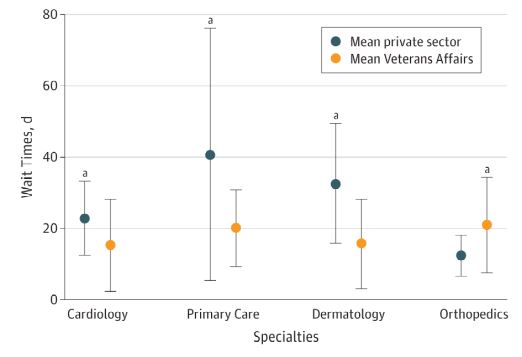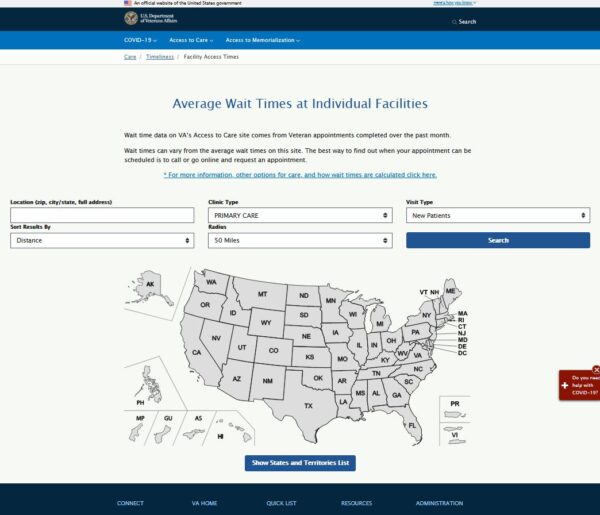WASHINGTON, DC — On its website, VA regularly reports misleading information on how long it takes for a veteran to be seen at its facilities, according to a recent VA Inspector’s General report. That can lead to confusion among veterans and anyone researching wait times, it added.
For example, the report issued last month noted, in 2019, that confusion led to a study being published by the Journal of the American Medical Association using incorrect data.
VA’s wait times have been under regular scrutiny since 2014 when it was reported that dozens of veterans died while waiting for appointments at the Phoenix, AZ, VA, which had an average wait time of 115 days. Subsequent investigations found that there were similarly long wait times at VA facilities around the country, and that some hospitals reported average wait times that were significantly lower than the real ones.
What followed were a series of investigations and reforms, most notably the Veterans Access, Choice and Accountability Act (Choice Act) of 2014, which required VA to publish data about wait times for medical appointments in VA facilities on a public website. It set a goal of no more than a 30-day wait time.

Comparison of Wait Times for New Patients Between the Private Sector and United States Department of Veterans Affairs Medical Centers
Wait Time by Specialty Each dot represents the mean wait time per new patient for an appointment in the private sector and Veterans Affairs facilities in 2017, stratified by specialty of care. The error bars indicate measures of uncertainty in SD.
a Significant comparison at P = .05. Source: JAMA Network Open
The wait times posted were to be from the appointment’s request date. VA later requested and was granted permission to change this to the clinically indicated date or the date when a provider feels the appointment is “clinically appropriate based on a veteran’s needs.”
VA continued to calculate some wait times from the request date, however, and others from the clinically indicated date. The agency also varied reporting techniques between new patients and established patients.
When VA created its Access to Care website in 2017, a description of wait times calculations on the site’s FAQ page said, “Measuring wait times from the date the appointment was requested until the date the appointment is completed is the most accurate measure for new veterans.”
However, the new patient wait times found on the website were calculated from the creation date—when the scheduler actually makes the appointment.
“For about four years, VA posted wait time data on two separate public websites using different start dates,” the report explains. “When VA posted wait time data on its public Patient Access Data website from 2014 through 2021, it measured both new and established patients from the clinically indicated date or veterans’ preferred date. When VHA began reporting its data on the new Access to Care website starting in 2017, it reverted to pre-2014 formulas. That is, VHA has been using the creation date for new patient appointments and the preferred date for established patients.”
This shifting definition of when the clock starts on wait-time calculations has caused confusion for years, even before the 2014 Phoenix scandal. It resulted in regular interactions between VA officials and Congress, with legislators asking for explanations on how wait times are calculated and expressing frustration over the gap between appointment request and appointment creation, which could lead to very different wait-time numbers.
The OIG report used a veteran seeking an appointment with a VA cardiac outpatient service as one example. While the appointment request and clinically indicated date was noted as 6/28/2021, the appointment was not created until July 21, 2021, for an appointment on Sept. 2, 2021. Calculated one way, it shows a wait time of 43 days. Calculated another, it shows 66 days.
In January 2019, a study published in JAMA Network Open, authored by current and former VA leaders, compared VA wait times for new patients to those in the private sector. The study stated the wait times were calculated using the appointment request date and went on to proudly demonstrate that VA facilities had shorter wait times than the private sector for primary care, cardiology and dermatology.1
During interviews with VA officials, OIG investigators discovered that the data VA used was measured from the appointment create date, which can vary widely from the appointment request date.
Unlike the scandals of 2014, the current OIG report is not alleging misconduct by staff, but rather placing blame on overall sloppiness and inconsistency in VA.
“No evidence of an intent or effort to mislead were found in regard to the wait time reporting allegations,” the report concluded. “However, the OIG observed during its review that VHA has been inconsistent and also not fully compliant with the Choice Act as well as the VHA directive in how it calculates wait times, and imprecise in how it has disclosed and explained its publicly reported wait time data. VHA’s efforts to improve the accuracy in its reporting of the timeliness of veterans’ access to care are dependent on the consistency of its calculations of wait times and its transparency regarding which methodologies and data sources have been used, together with any limitations.”
- Penn M, Bhatnagar S, Kuy S, et al. Comparison of Wait Times for New Patients Between the Private Sector and United States Department of Veterans Affairs Medical Centers. JAMA Netw Open. 2019;2(1):e187096. doi:10.1001/jamanetworkopen.2018.7096



